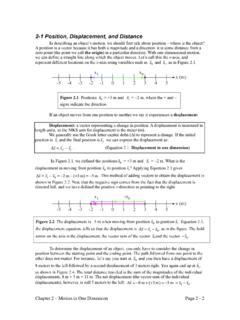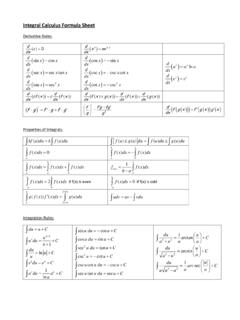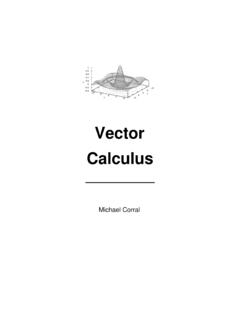Transcription of Key Concepts in Language and Linguistics - cob-net.org
1 KEY Concepts IN Language ANDLINGUISTICS This is brilliant book. It combines the readability of Pinker with thebreadth and erudition of Crystal, and deserves a place of honour as asummary of the best of twentieth-century Linguistics liberal,scholarly, forward-looking, undogmatic, sensible, practical andabove all wide ranging. Every linguist will be pleased with most every student will cling to it and love it. Richard Hudson, University College LondonKey Concepts in Language and Linguistics is an A-Z guide to the main terms andconcepts used in the study of Language and Linguistics . The book includesdefinitions of: terms used in grammatical analysis from phoneme to componential analysis; branches of Linguistics from semantics to neurolinguistics; approaches used in studying Language from critical discourse analysis toSystemic Linguistics ; linguistic phenomena from code-switching to conversational implicature; Language varieties from pidgin to standard entry begins with a brief definition of the term followed by a more detaileddescription.
2 Entries trace the origin of the concept, mention the key associatedindividuals, provide a guide to further reading and are extensively is Professor of Linguistics at the University of Sussex. His numerouspublications include The History of Basque (1996), Language : The Basics(1995), A Dictionary of Phonetics and Phonology (1995) and A Dictionary ofGrammatical Terms (1993). KEY Concepts SERIESO ther titles available from RoutledgeKey Concepts in Communication and Cultural Studies (second edition) TimO Sullivan, John Hartley, Danny Saunders, Martin Montgomery and John FiskeKey Concepts in Cinema Studies Susan HaywardKey Concepts in Post-Colonial Studies Bill Ashcroft, Gareth Griffiths and HelenTiffinKey Concepts in Popular Music Roy ShukerKEY Concepts INLANGUAGE and New YorkFirst published 1999by Routledge11 New Fetter Lane, London EC4P 4 EESimultaneously published in the USA and Canadaby Routledge29 West 35th Street, New York, NY 10001 1999 1999 Routledge is an imprint of the Taylor & Francis GroupThis edition published in the Taylor & Francis e-Library, 2005.
3 To purchase your own copy of this or any of Taylor & Francis or Routledge s collection ofthousands of eBooks please go to All rights reserved. No part of this book may be reprinted orreproduced or utilized in any form or by any electronic,mechanical, or other means, now known or hereafter invented,including photocopying and recording, or in any informationstorage or retrieval system, without permission in writing fromthe Library Cataloguing in Publication DataA catalogue record for this book is available from the BritishLibraryLibrary of Congress Cataloguing in Publication DataTrask, (Robert Lawrence) 1944 Key Concepts in Language and Linguistics / cm. (Key Concepts )Includes bibliographical references and 0-415-15741-2 (HB). ISBN 0-415-15742-0 (PB).1. Linguistics Dictionaries. I. Title. II. 1998410 .3 dc21 98 24025 CIPISBN 0-203-29906-X Master e-book ISBNISBN 0-203-26534-3 (Adobe eReader Format)ISBN 0-415-15742-0 (Print Edition) (Pbk)ISBN 0-415-15741-2 (Hbk) CONTENTS Preface and acknowledgements vi List of Key Concepts viii KEY Concepts Bibliography 232 Index 2431 PREFACEThe book in your hand is neither a dictionary nor an encyclopedia, but somethingin between.
4 As its title suggests, it provides fairly detailed coverage of nearly 300key Concepts in the study of Language . The named Concepts selected for inclusionare all among the most important in the field, and among those which everybeginning student is likely to Concepts are taken from every area of Language study, from traditionalgrammar to contemporary grammatical theory, from child Language to languageand brain, from lexicography to the linguistic study of literary texts, from men sand women s speech to Language and power. Each entry provides a briefdefinition of the term entered and then goes on to explain the concept in somedetail often with numerous examples and it also introduces and explainsrelated terms, which are given in bold italics. Wherever possible, the historicalorigins of the concept are described, including the time of introduction and thenames of individuals who have made the concept prominent. When a concept iscontroversial, the entry says so.
5 Cross-references to other Concepts with theirown entries are frequent, and are always given in boldface. In most cases, theentry concludes with cross-references to other entries which are related, and witha list of suggested further reading, usually arranged from briefest and mostelementary to most advanced and comprehensive. A complete bibliography ofthe suggested reading is provided after the main part of the book. Where little orno further reading is suggested, this usually means that the concept, thoughfundamental, is often maddeningly difficult to look up in textbooks, and here Ihave been at pains to provide the kind of explanation not readily the front of the book you will find an alphabetical list of all the conceptswith their own entries. At the end, you will find a detailed index; this includes notonly the terms entered as headwords but also all other terms introduced withinentries. So, if you don t find the term you re looking for in the main list, be sureto check the index, which includes hundreds of additional terms.
6 The index alsoincludes references to individuals named in the hope that this book will prove to be of great utility to students undertakingthe study of almost any aspect of Language for the first time, either atundergraduate level or at post-graduate am indebted to Kieron Corless for inviting me to write this book, and to NicolaWoods, Lyn Pemberton and Richard Coates for various types of advice andassistance in the writing of , UKOctober 1997 viiKEY CONCEPTSA accentadjectiveadverbaffixagreementairst ream mechanismalternationambiguityanalogyanap horanimal communicationanthropological linguisticsaphasiaapparent timeapplied linguisticsarbitrarinessargumentartifici al languageaspectautonomy of languageauxiliaryBbasic word orderbehaviourismbilingualismbioprogram hypothesisBlack EnglishCcaregiver speechcaseclausecode-switchingcognitive linguisticscognitive sciencecoherencecohesioncolloquial speechcommunicative competencecomparative reconstructioncompetencecomplementcompon ential analysiscomputational linguisticsconjunctionconnotationconsona ntconstituent structureixcontrolconversational implicatureconversation analysiscooperative principlecoordinate structurecopulacorpuscreolecritical discourse analysiscritical period hypothesisDdead languagedeep structuredeficit hypothesisdeictic categorydenotationdependencyderivationde scriptivismdesign featuresdeterminerdiachronydialectdiglos siadiscoursediscourse
7 Analysisdisplacementxdistinctive featuredistributionduality of patterningdyslexiaEellipsisentailmenteth nography of speakingetymologyexperimental approachFfinitefocusfolk linguisticsfunctionalismfunctions of languageGgapgendergenerative grammargenetic hypothesis of languagegenetic relationshipgenregiven/newgovernmentGove rnment-and-Binding Theorygrammarxigrammatical categorygrammatical relationgraphemeHheadhistorical linguisticsIiconicityidiomimmigrant languageIndo-Europeaninflectioninnatenes s hypothesisinternal reconstructioninternational languageInternational Phonetic Alphabetintertextualityintonationintuiti onKkinship termsknowledge about languageLlanguagelanguage acquisitionlanguage acquisition devicelanguage and ethnicitylanguage and identityxiilanguage and ideologylanguage and powerlanguage areaslanguage changelanguage contactlanguage deathlanguage disabilitylanguage facultylanguage familylanguage instinctlanguage in uselanguage mythslanguage planninglanguage processinglanguelateralizationLexical-Fu nctional Grammarlexicographylexiconlingua francalinguistic arealinguistic relativity hypothesislinguisticslinguistic signliteracyloan word localizationlogonomic rulesxiiiMmanner of articulationmarkednessmeaningmediummenta lismmetalanguagemetaphorminimal pairminority languagemodalitymodifiermodularitymoodmo rphememorphologymovementNnamenarrativena tional languagenatural classnatural languagenatural- Language processingneurolinguisticsneutralization nominalizationnon-verbal communicationxivnotational conventionnounnoun phrasenumbernumber of languagesOofficial languageonomasticsopen-endednessoracyori gin and evolution of languageorthographyPparadigmparadigmatic relationparalanguageparolepart of speechperceptual strategyperformanceperformativepersonphi lologyphilosophy of languagephonation typephonemephoneticsxvphonologyphonotact icsphrasephrase-structure grammarpidginplace of
8 Articulationpolitenesspragmaticspredicat eprepositionprescriptivismpresupposition productivity pronounprosodyproto-languageprotolanguag e hypothesispsycholinguisticspunctuationpu rismQqualitative approachquantitative approachRraisingreconstructionrecursionr eferencexvirootruleSsandhiSaussurean paradoxsegmentselection restrictionsemantic rolesemanticssemioticssensesense relationsentencesex differences in languagesexist languagesign languageslang social history of languagesocial stratification of languagesociolinguisticssound symbolismspeechspeech actspeech communityspeech eventspeech soundspellingstandard languagexviistemstimulus-freedomstressst ructuralismstructurestructure-dependence stylisticssubcategorizationsubordination suprasegmentalsurface structuresyllablesymbolic systemsynchronysyntactic categorysyntagmatic relationsyntaxsystemsystematic correspondenceSystemic LinguisticsTtensetexttext linguisticstextuality tone languagetopictraditional grammarxviiitranscriptiontransformationa l grammartransitivitytreeturn-takingtypolo gyUuniversaluniversal grammarusageutteranceVvariationverbverb phrasevernacularvocal tractvoicevoicingvowelWwell-formednesswo rdword-formationwriting systemxixAaccent A particular way of pronouncing a Language .
9 For any Language with morethan a handful of speakers, there are prominent regional, social and individualdifferences in the way the Language is pronounced by different people;sometimes these differences are dramatic. Each distinguishable type ofpronunciation is called an accent. Depending on where we come from and whatexperience we have, we will be able to identify accents different from our own withmore or less precision: in the case of English this may be an American accent, aDeep South accent, a Scottish accent, a working-class London accent, a Frenchaccent (from a non-native speaker) and so on. Speakers of all languages can dothe is important to realize that everybody has an accent: it is not possible tospeak a Language without using some accent or other. Of course, every one of usregards some accents as more familiar than others, or as more prestigious thanothers, but that is a different matter: we are merely more sensitive to accentswhich differ strongly from our own.
10 A friend of mine with an impeccable middle-class south-of-England accent which attracts no attention in London once visitedYorkshire, where a wide-eyed little girl, after listening to him for a few minutes,finally confided to him, in a broad Yorkshire accent, Ee tha talks funny. In Britain, the single most prestigious accent is Received Pronunciation, orRP, an accent which seems to have arisen in the prestigious public schools (private schools) in the nineteenth century. This accent is not associated with anyparticular region, though it is structurally most similar to certain accents of thesoutheast of England. No more than three per cent of Britons speak with an RPaccent, though many more have a near-RP accent which differs only in a fewparticulars. RP is the accent usually taught to foreign learners of English inBritain. Nevertheless, regional and social variation in accents in Britain is verygreat, greater than anywhere else in the English-speaking world, and the urbanaccents of Newcastle, Glasgow or Liverpool may be unintelligible to the USA, distinctive and readily identifiable regional accents of English areconfined to New England, the east coast and the south, the areas which havebeen settled longest.


